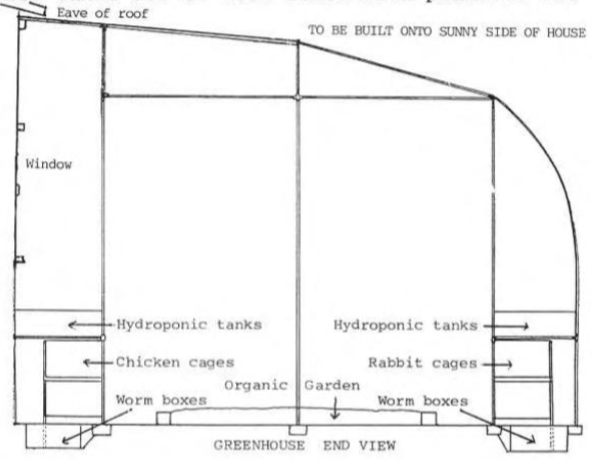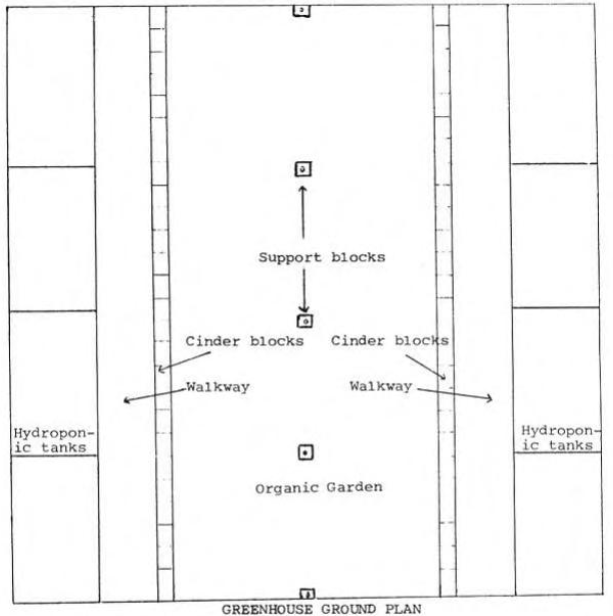Saxon's Survival Hour #200: Efficient Greenhouse
Today's excerpt begins on page 271 of The Survivor Volume 1.

The greenhouse on the facing page is simple, inexpensive and can be assembled by any builder who is handy.
It is entirely composed of metal tubing, plastic and cinder blocks. The hydroponic tanks are lined with plastic.
The cages can be bought cheaply from most farm supply stores or you can make them yourself from materials bought through any hardware store.
In later issues I'll give diagrams and instructions for each item.
Even so, depending on your space requirements, you could have a larger or smaller setup built from the illustration of the ground plan and end view.


FROM THE GROUND UP
by Kurt Saxon
In a further clarification of my food factory in a greenhouse, I will start from the ground up, which will be the raising of the earthworms.
Earthworms are a very valuable asset to any greenhouse.
They not only reduce the organic waste into the best compost available but they can be fed to chickens or sold to fishermen.
It's true that those who get rich from selling worms are selling them to people who want to get rich selling worms.
So forget about big profits for now.
You should start out with only a few thousand and keep your operation small.
This is only a basic course teaching you the principles of raising worms.
When you know more about them and gain the proper perspective, you can expand to whatever volume you can handle with ease.
Even before you build your greenhouse, you can learn the art of raising worms and maybe sell enough of their castings to pay for your investment.
Worm castings are sold mainly for house plants and bring up to $1.00 per pound.
You might find a local greenhouse owner who would buy all you can produce for resale to their customers.
Even if you don’t market the castings, you can dry and save it for potting your own greenhouse plants.
Your surplus worms can be sold to pet shops to feed the fish and birds.
They can also be put up in easily available plastic cartons with covers in batches of a dozen big worms and a handful of their growing media.
These can be placed with any business catering to fishermen.
The main thing is getting started.
This involves collecting the worms, boxes and worm food.
First, write the sources below for information on prices of worms and the sellers’ own ideas on raising and selling them.
Next, make four wooden boxes from 3/4 to one inch thick lumber, scrap or from a building supply store.
The boxes should be two by two foot square and five inches high.
If you are not at all handy, anyone working in a lumber yard can make them for you for a few dollars.
Then you will need two more of the same size boxes but with 1/4 and 1/8 mesh screens nailed to the bottoms of the boxes instead of wood.
These are shaker boxes used in separating the bedding, castings and worms.
To start, buy a bag of black Michigan peat moss at a garden store.
With the 1/4 inch screen shaker box, fill two of the boxes to within 1/2 inch from the top.
Any peat which won’t go through should be discarded unless you can shred it finer.
Then put 1,000 worms on top of the peat in each box.
When they have burrowed under, fill the boxes with dried cattle manure which has not boon chemically treated.
You can buy this at any garden store, also.
Then, using a garden sprinkling can, sprinkle one gallon of water evenly in each box.
Next, store the boxes in a cool place, not below 50 degrees, and not touching the ground if it is wet.
Put the two extra boxes bottom side down on the full boxes as covers.
Then let everything alone for ten days.
After 10 days fill one of the extra boxes to within a half inch of its top with more black Michigan peat sifted through the 1/4 inch screen.
The worms will pretty well digested the contents of the two boxes as well as reproducing quite a few more worms.
Aside from the worms, all that will be left will be little pellets of worm castings and some uneaten black Michigan peat.
To separate the castings from the worms and peat you’ll need the 1/8 inch screen box and a table to shake the castings onto.
Take a few handful is of worms, peat and castings at a time and put them in the screen box.
Shake over the table until most of the castings have fallen through.
Dump the worms and peat into a dishpan or other large container.
When you’ve emptied both boxes give the worms time to burrow down to the bottom of whatever peat is left.
Then scrape the peat off the worms and put it in the empty box. Next, put more peat into that box until it, too, is refilled to within a half inch of the top.
Then separate the worms into two piles and divide them between the two boxes as before.
Again cover them with cattle manure and sprinkle a gallon of water on each.
After the next ten days you may have enough extra worms to start another box.
Even so, your first ton days should give you from 24 to 28 quarts of castings.
As you perfect your techniques and gain a complete understanding of the process, you can branch out to a profit-making enterprise.
By the time you have your greenhouse established, you will be ready with plenty of worms.
Then, instead of commercial black Michigan peat moss for bedding, you can use plant waste shredded by a mechanical shredder you will soon be able to afford.
Bedding can also be supplemented by finely shredded newspaper, corrugated cardboard, grass, leaves or any other organic waste matter.
Just so it’s fine enough to go through a 1/4 inch screen, helping it to hold moisture more uniformly, is easier for the worms to move through and eat and also because it's easier to work with.

Kurt Saxon thought civilization would have collapsed by now.
He spent the majority of his life collecting knowledge of home based business.
His goal was for all his readers to survive at a more comfortable level than those that were less provident.
He knew the importance of communicating at a level folks could understand.
Most of what he has compiled for our benefit can be easily understood by everybody.
He also includes a subtle sense of humor.
You can find the majority of his life's work here.
Hear him read his stories.
Posts with rewards set to burn only burn the author's portion of the rewards. Curators still get paid.
IF you think this content should be eligible for rewards from the content rewarding pool, please express your discontent in this discord:
Eartworms also make the soil fertile.
I suspect Kurt Saxon was an undocumented polymath, sociopath, and all around good guy.
Thanks!
Yeah, he was something.
I met him twice.
Those sound like seminal events. You have led a life, my friend.